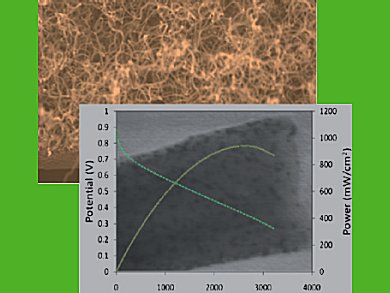Proton-exchange membrane fuel cells (PEMFCs) provide an alternative energy source, but to date the highest performance for PEMFCs has been repeatedly demonstrated using rare transition-metal catalysts, specifically Pt and Pd. Progress in the commercialization of PEMFCs has been significantly impeded due to this catalytic expense.
Jun Chen, University of Wollongomg, Andrew I. Minett, University of Sydney, both NSW, Australia, and colleagues have demonstrated improved power and energy densities in a single PEMFC using a designed cathode with a Pt loading of 0.1 mgcm–2 on a mesoporous conductive entangled carbon nanotube (CNT)-based architecture.
This electrode allows for rapid transfer of both fuel and waste to and from the electrode, respectively. Pt particles are bound tightly, directly to CNT sidewalls by a microwave-reduction technique, which provided increased charge transport at this interface. The Pt entangled CNT cathode, in combination with an E-TEK 0.2 mgcm–2 anode, has a maximum power and energy density of 940 mWcm–2 and 2700 mAcm–2, respectively, and a power and energy density of 4.01 WmgPt –1 and 6.35 AmgPt –1 at 0.65 V. These power densities correspond to a specific mass activity of 0.81 g Pt per kW for the combined mass of both anode and cathode electrodes.
The single-cell performance has the potential to be further improved by optimizing the thickness and mass of the base layer of the architecture. Apart from the cathode, the electrode has the potential to replace the gas-diffusion layer in a fuel cell.
- Microwave Decoration of Pt Nanoparticles on Entangled 3D Carbon Nanotube Architectures as PEM Fuel Cell Cathode,
Peter C. Sherrell, Weimin Zhang, Jie Zhao, Gordon G. Wallace, Jun Chen, Andrew I. Minett,
ChemSusChem 2012.
DOI: 10.1002/cssc.201100667



